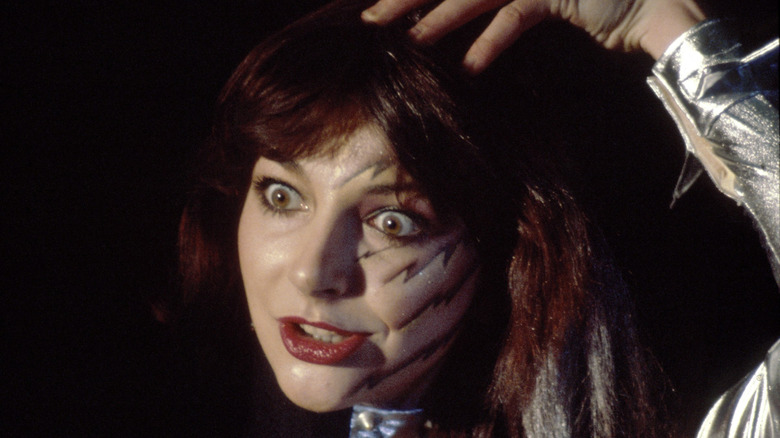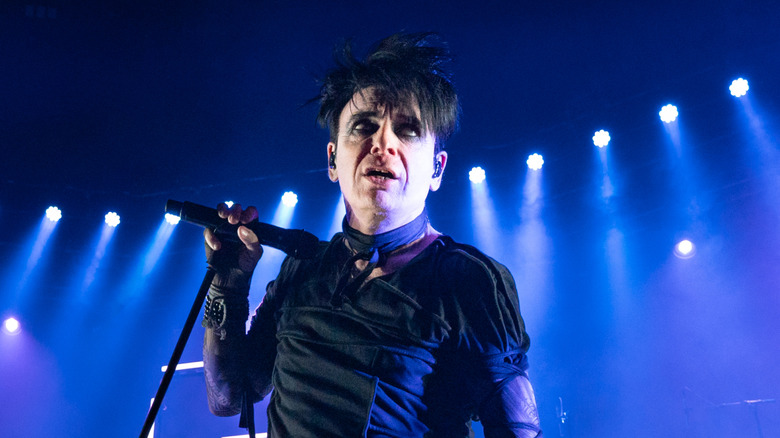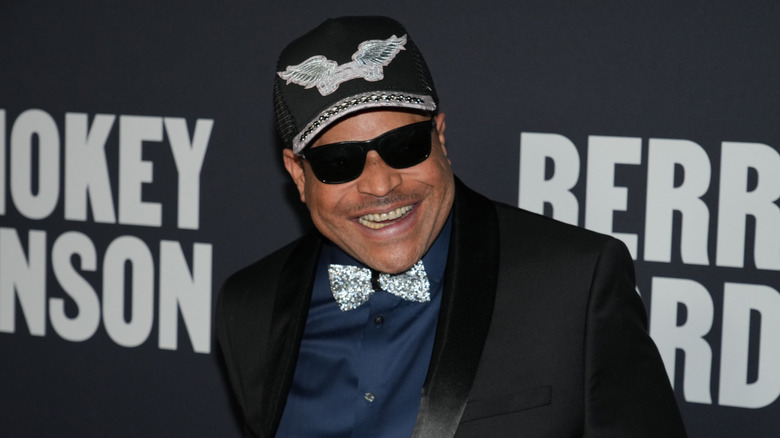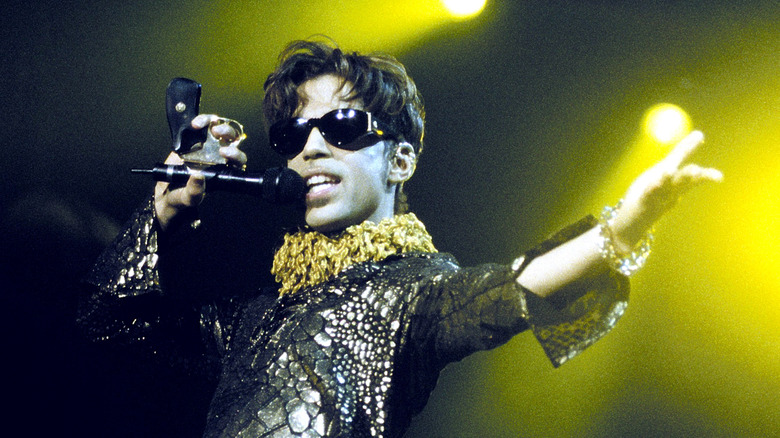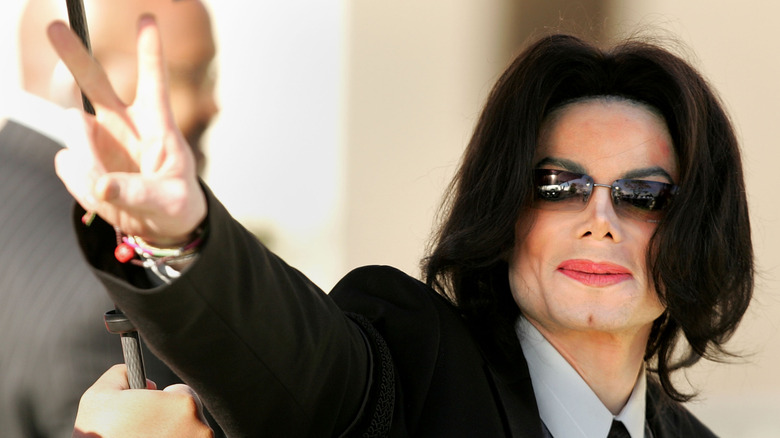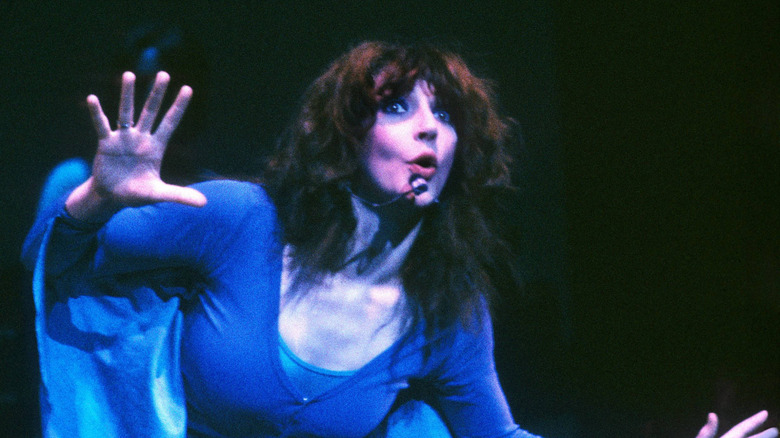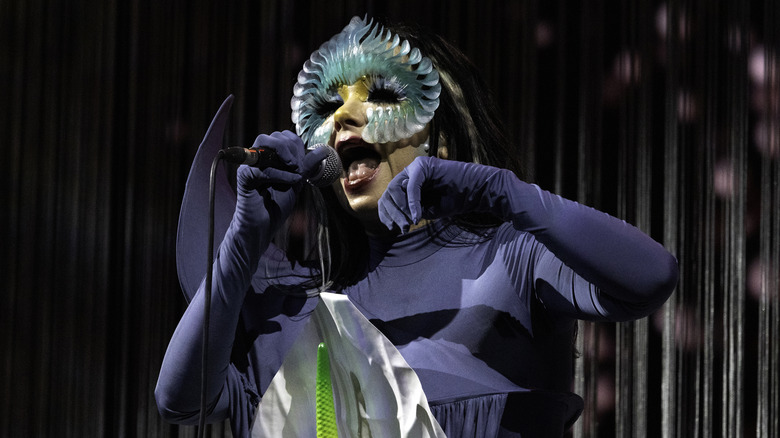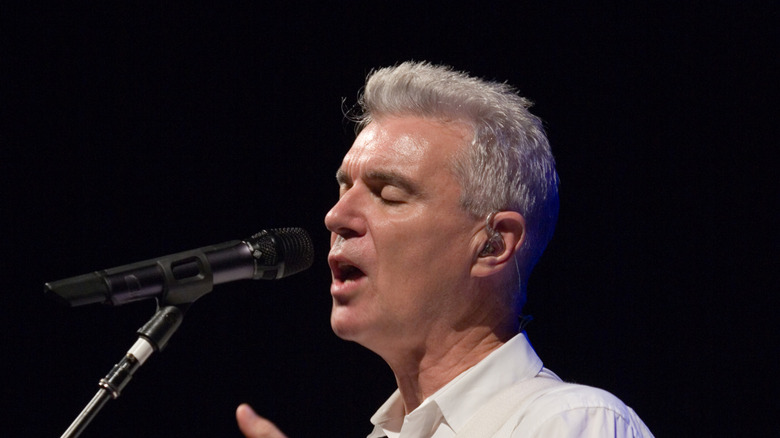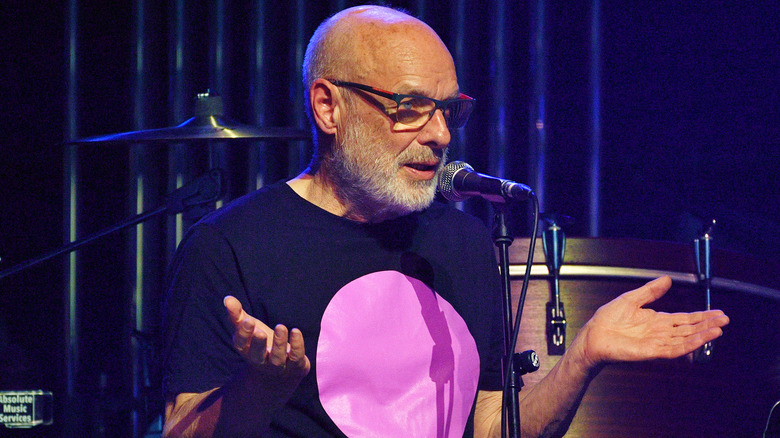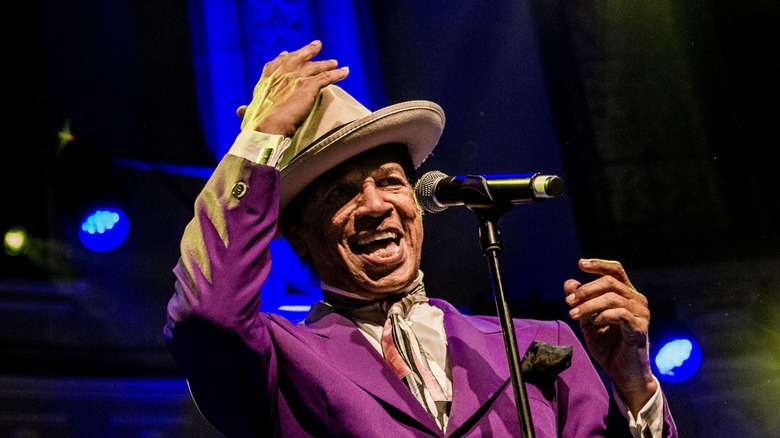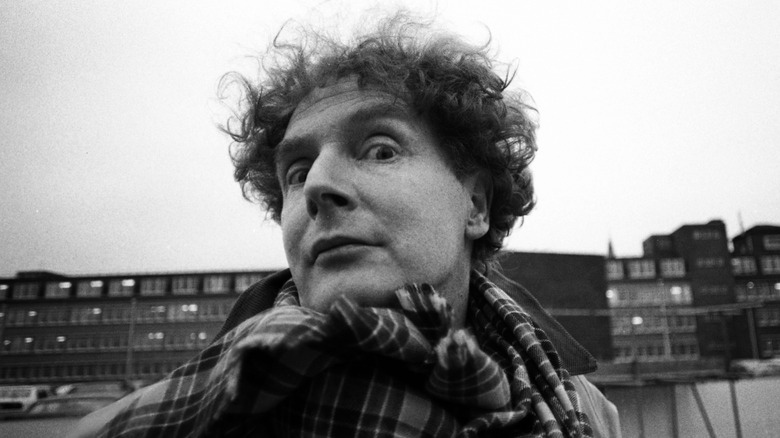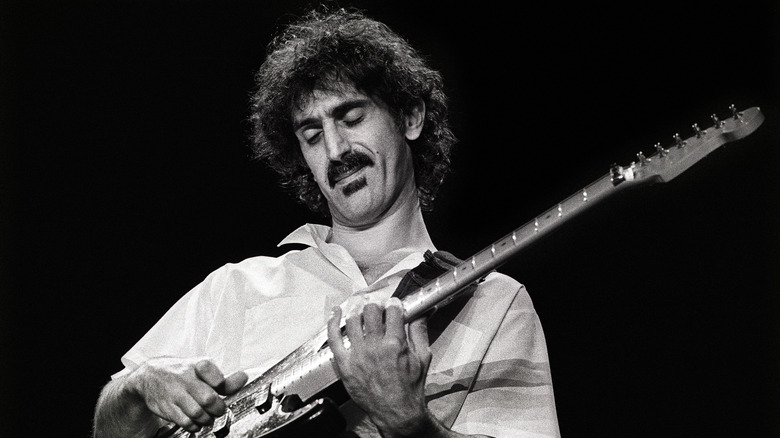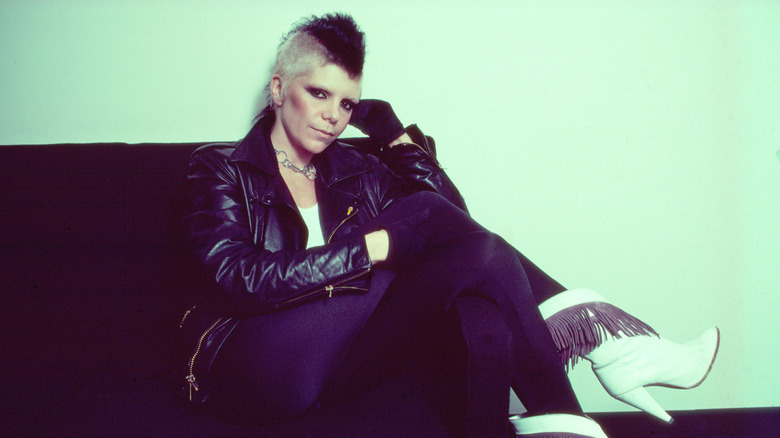'80s Musicians Who Were Really Weird People
Some famous musicians are what we might politely call "mercurial," and what we might more bluntly call "weird." There are probably several reasons for this; perhaps it's the worldwide fame and adoration. Maybe their creative muses are also a little bit squirrely, or it could be that there's some kind of gene present only in those with musical talent that also makes them more likely to, say, keep an aquarium full of diamond-encrusted pet turtles. Or maybe it's drugs.
At any rate, the '80s were a particularly weird decade, and the messed-up truth of the decade's music industry is that many of the folks that gifted us with our most beloved popular tunes from that era also sometimes gifted us with other things — like headlines about their latest public displays of eccentricity, performances awkward enough to make the sound guy squirm, and interviews that left us staring at the television, our faces stuck with an expression like a fourth-grader trying to perform calculus. Here are some of the weirdest of the weird music superstars of the "Decade of Excess"(ive weirdness).
Gary Numan
Although his band Tubeway Army scored a hit in the U.K. with the song "Are 'Friends' Electric," in 1979, synth maestro Gary Numan will forever be best-known for his smash single "Cars," a U.S. top 10 hit in the summer of 1980. Most guys in their early 20s would have been riding a huge wave of ego after scoring two massive hits within the space of a year or so, but not Numan. Despite his pop star ambitions, he was a socially awkward sort who suffered from intense stage fright. He dealt with this in a novel fashion — by cultivating a robotic, almost alien stage persona that masked his desire to be virtually anywhere but performing in front of people.
Speaking with The Guardian in 2013, Numan explained, "The whole image was my way of getting around the fact I was cripplingly shy. ... The image was a way to create a front I could hide behind." This persona is on full display in the iconic video for his most famous tune, which not-so-coincidentally includes lyrics like, "Here in my car / I feel safest of all / I can lock all my doors / It's the only way to live." Fortunately, as he got older, Numan became a bit more comfortable. "I [used that persona] for long enough that it enabled me to feel natural, and then I didn't need it anymore," he said.
Rockwell
If the name "Rockwell" instantly evokes images of a sketchy, paranoid shut-in, it's probably because you only remember it as the name of a guy who always feels like somebody's watching him. With an ever-so-slight assist on the chorus from Michael Jackson, Rockwell's 1984 single "Somebody's Watching Me" raced straight to No. 2 on the Billboard pop chart, with follow-up "Obscene Phone Caller" cracking the top 40 a few months later. If you see a theme developing there, well, aren't you a keen-eyed devil?; Rockwell was a purveyor of what could accurately be described as "Paranoia Rock."
In keeping with the weird subject matter of his tunes, the man himself was a touch eccentric. At the time of his chart run, few knew that he was actually the son of legendary Motown Records founder Berry Gordy Jr.; while Rockwell was indeed signed to Motown, he had managed to secure his contract without his Dad's knowledge. So determined was he to avoid the appearance of nepotism that he went so far as to pretend, for a time, to be from England. Yes, that odd accent he employs in "Somebody's Watching Me" was an attempt at a British accent, and for a while, he actually spoke that way in interviews as well.
Prince
It's no secret that Prince was a bit of an oddball; heck, he was famously a devout Jehovah's Witness prone to writing songs with titles, to say nothing of lyrics, that are too racy to print here. He was just as famously enamored of the color purple, and would go so far as to insist that nobody sharing the stage with him — not just bandmates, but even opening acts — be allowed to wear the color. Typical rock star stuff, perhaps, but there's so much more.
Prince was fond of a number of athletic pursuits, including basketball (which he absolutely excelled at despite being very short), ping pong, and roller skating. Roots drummer Questlove once related a story about a skate party he had attended in which Prince had donned "the strangest, most singular pair of roller skates [he] had ever seen ... They were clear skates that lit up, and the wheels sent a multicolored spark trail into your path" (via Page Six). Sure, sounds about right.
But consider that the famously prolific musician managed to be so prolific by essentially never sleeping, bragging in a 1985 interview that he had yet to meet the person who could stay awake longer than he could (via BBC). Perhaps this is because, to Prince, time had no meaning. No, really. In a 2011 Guardian interview, he offered that he never celebrated his birthday, which is why he never really seemed to age. "Time is a mind construct," he helpfully explained. "It's not real."
Michael Jackson
Now, everybody knows that the late, great King of Pop, Michael Jackson, was just a tad eccentric; you don't build an amusement park called "Neverland" and live in it otherwise. In the '80s, though, he seemed to develop a tendency to experiment with different flavors of weirdness on a daily basis; one could make the case that he might have single-handedly kept a tabloid or two in business during that period.
First, there was his preference for exotic pets, and we do mean exotic. He had a pet chimpanzee named Bubbles who, for a time, accompanied him seemingly everywhere (including the recording studio), and a big-ass boa constrictor named Muscles, which frankly sounds like a Simpsons gag.
Then, there were his sleeping accommodations; in the mid-80s, he cultivated a fondness for snoozing in hyperbaric oxygen chambers, coughing up about a million bucks for a Culver City, California, hospital to borrow one for his regular use. (He later bought the thing off the hospital so he could use it full-time.) Finally, we would be remiss not to mention his obsession with John Merrick, the famous "Elephant Man." Scratch that — it was not so much an obsession as an "absorbing interest," according to Jackson's manager Frank Dileo (via Chicago Tribune). Said interest prompted the singer to offer up a cool $1 million to acquire Merrick's remains from the London Hospital Medical College, which turned down the offer.
Kate Bush
The English singer-songwriter Kate Bush was a blind spot for many Americans until her 1985 single "Running Up That Hill" blew up all over the place in 2022 after being featured prominently in the hit Netflix series "Stranger Things." This may be because Bush is very, very eccentric, and also very, very British. She's also ridiculously talented. As a teenager, Bush — like many teens — filled up notebook after notebook with poetry; unlike many teens, though, hers was evolved, lyrical, and highly sophisticated. A family-produced demo tape caught the attention of Pink Floyd guitarist David Gilmour, who financed a professionally-made demo, which resulted in Bush being signed to EMI Records while still in high school.
Her debut single "Wuthering Heights," essentially a musical retelling of the classic Bronte novel sung in a bizarre, warbling, operatic tone, somehow failed to make much of a splash in the U.S. while rocketing straight to No. 1 in the U.K. Bush rightly figured that this gave her license to indulge her extremely weird muse to her heart's content; subsequent hit singles leaned into her theatrical, literary tendencies. While her U.K. fans adored her for this, the U.S. audience responded mostly with absolute bewilderment. Her biggest stateside hit before the late resurgence of "Hill" was the 1987 Peter Gabriel duet "Don't Give Up," which was propelled all the way to No. 72 by a video which consists solely of Bush and Gabriel singing the song while hugging as the camera spins around them.
Bjork
Bjork began her rise to fame in the '80s as a member of the Sugarcubes. She's slightly more well-known, though, for her solo work, having notched a couple of Hot 100 singles in the U.S., and for her unconventional vocal style and musical sensibility. She's much, much more well-known for her even more unconventional fashion sense. That is to say that for most of her time in the public eye, she's been prone to showing up to concerts and in public appearances wearing outfits that made '70s Elton John look downright conservative.
Her greatest hits in this respect are too numerous to list. There's the 2003 concert in which she performed while apparently covered in doilies; the Prince's Trust appearance the same year during which she wore a full jewel-encrusted face mask; the 2008 tour with the completely head-obscuring headdress made of huge pom-poms; the 2012 festival appearance with the "dress" apparently made of... well, oily black tubes. A 2006 U.K. poll singled her out as the most eccentric celebrity in the world; that was two decades ago. If anything, Bjork has doubled down on the weirdness in recent years; in 2023, she appeared in concert in Tokyo wearing an outfit that could accurately be described as "an exploding, ice-covered Christmas Tree."
David Byrne
Talking Heads and their enigmatic frontman David Byrne were perhaps the weirdest band to come from the late '70s New York City punk scene and its hub, the legendary CBGB. They stood out by virtue of, well, not being punk at all; in fact, they were clean-cut, rock-solid musically, with a decidedly poppy yet eclectic sound. Of course, they also fielded a signature tune in which Byrne sang with livewire nervousness from the point of view of a serial killer while randomly slipping into French.
Byrne's flighty muse would stick the Heads with labels such as "art rock" and "progressive funk" for their entire career, but their aesthetic defied labels, even really weird ones. Perhaps this is because Byrne was something of a walking contradiction: a famously emotionally reserved man who nevertheless penned singles about the simple joys of genuine love and how awesome babies are, a seemingly reluctant frontman whose stage presence was never anything short of electrifying, a complete geek and a bona fide rock star. Perhaps the purest distillation of Byrne's singular oddness: the 1986 feature film "True Stories," which he co-wrote (with the amazing comedic character actor Stephen Tobolowsky) and directed; it's perhaps the most off-kilter major movie you'll ever see. If you don't have that much time, simply revisit the Heads' immortal video for "Once in a Lifetime," in which Byrne hyperventilates and pours buckets of sweat while doing African tribal dances and singing like a cross between a street preacher and an android.
Brian Eno
While he got his start as the keyboardist for the English band Roxy Music, Brian Eno is much better-known as a producer — a cracking good one who has worked with the likes of David Bowie, U2, and yes, Talking Heads. His production style tends to bring out the weirdass best in the artists he produces, and this is probably because he approaches his craft from a mindset that literally nobody else on Earth does. He basically sees no distinction between art, science, or any other type of cultural expression, and he's spent his professional life essentially looking for a grand unified theory of culture.
Speaking with Edge in 1997, Eno elaborated on this view. "I want to find a single language within which one can talk about fashion, cake decoration, Cezanne, abstract paintings, architecture," he explained. "There should be one language that fits these things together ... there is a deep connection between art and science. Each is a highly organized form of pretending; of saying, 'let's see what would happen if the world was like this.'" One look at his production credits makes it clear that he's not just whistling Dixie — Bowie's "Heroes," Blondie's "Eat to the Beat," Devo's "Q: Are We Not Men? A: We Are Devo," the Heads' "Fear of Music" and "Remain in Light," and the soundtrack to David Lynch's 1984 adaptation of "Dune," to name a few.
Kid Creole
One might reasonably expect the leader of a band called "Kid Creole and the Coconuts" to be a bit of an odd one, and said expectations would be accurate. August "Kid Creole" Darnell was the creator of an aesthetic that few would ever conceive of, let alone ride to commercial success. The "Tropical Gangster" had a dapper, Zoot-suited, wingtip shoes kind of fashion sense, and his music was a sonic melting pot of disco, Harry Belafonte-esque Caribbean grooves, and Cab Calloway-style big band bombast. They had a string of hit singles in the U.K. with titles like "Annie, I'm Not Your Daddy," "The Lifeboat Party," and "Don't Take My Coconuts." (It may help to know that the "Coconuts" were Darnell's scantily-clad backup dancers.)
In a 1981 New York Times interview, Darnell described his latest album, "Fresh Fruit in Foreign Places," thusly: "One way of looking at the journey Kid Creole undertakes on the record is as a justification of the many strains that coexist in our music. The journey is autobiographical in that it explains how the music came to be the music that it is." Speaking with The Guardian in 2011, Darnell — who, incidentally, has a Master's degree in English — explained that his music and persona were always meant as satire. "I'm a capitalist and I love money, but originally we frowned on it — the idea of the elegant elite," he said. "Then we became the thing we made fun of."
Malcolm McLaren
Malcolm McLaren is not known so much for his own musical endeavors. He's far better known for being the guy who dressed up a bunch of no-talent British ruffians in rags from his clothing shop (called "Sex"), threw them onstage with instruments, and made them yell about how wack British society was. They were, of course, the Sex Pistols, who probably got their name from McLaren's store. While their career lasted for all of six months and one album, they certainly left their mark on punk music.
Those who new McLaren described him as one of the most flighty individuals ever; equally capable of kindness and cruelty, deep insight and pure horse crap, a man with a keen eye for talent whose biggest act had none. The depth of his weirdness is illustrated by the highly unlikely hit single fielded by his own outfit, Malcolm McLaren's World Famous Supreme Team: a dancey, electronica-flavored, scratch-infused proto-rap record featuring lyrics that were mostly just recycled square dance chants. "Buffalo Gals" peaked at 65 on the U.K. charts, and its video showed up on MTV in the network's early days when it would play pretty much anything. The song has been sampled or interpolated hundreds of times in the years since its brief time in the spotlight, most notably in Eminem's 2002 single "Without Me."
Frank Zappa
Certified weirdo-slash-genius Zappa's lone pop hit came in the early '80s, which was not an expected circumstance. The song in question featured Zappa's vocals on the chorus, mocking oblivious upper-class girls from the San Fernando Valley; the verses belonged to his teenage daughter Moon, who simply spouted a fountain of the type of jargon associated with said girls. The result: "Valley Girl," which coined that term, got virtually every kid in America mimicking its twisted take on teenage slang, and became Zappa's only top 40 single.
It's a testament to Zappa's whole weird aesthetic that the song was a brutal takedown, a parody that went over everyone's heads. For the entirety of his career, which began in the '50s, he was supremely uninterested in making music that could even loosely be described as "accessible." Taking his influences from classical, jazz, chamber music, and literally anything and everything else, Zappa's compositions were famously, flagrantly intricate and demanding. His band the Mothers, later the Mothers of Invention, had a revolving lineup composed of supremely talented musicians; later in his life, Zappa circumvented the need to work with players who could keep up by recording a ton of compositions (and one entire album, "Jazz From Hell") on the Synclavier II, the first digital audio workstation.
Wendy O. Williams
The Plasmatics, formed by manager Rod Swenson in the late '70s, are perhaps the single most provocative band in history. Indeed, provocation was pretty much the reason for their existence, and lead singer Wendy O. Williams wasn't so much a frontwoman as she was the embodiment of the band's non-conformist credo. "She had this attitude that she'd rather be dead than part of this conformist world," Swenson said of his muse in an interview. "[Plasmatics were] a concept set up around Wendy Williams. She would be the centerpiece" (via Louder).
The band quickly became notorious for staging several of the craziest performances in rock history; taking sledgehammers to televisions, chainsawing guitars in half, and literally blowing up cars. A national television appearance on the late-night variety show "Fridays" quickly made Williams the poster child for terrifying musical anarchy; in its wake, Williams, Swenson, and other band members were closely monitored by police at their shows, and were arrested multiple times (not to mention beaten senseless) for public indecency.
While Williams went on to success as a solo artist under the wing of KISS bassist Gene Simmons, her allergy to conformity remained. In a 1987 interview with journalist Frank Lovece, she spelled out her worldview. "It's easy to go with the flow, easy to go with the formula ... Everybody does not have to have the same taste. I don't sing like anybody else," she said. "The way I sing is fun, and if somebody doesn't like it, tough s**t."
